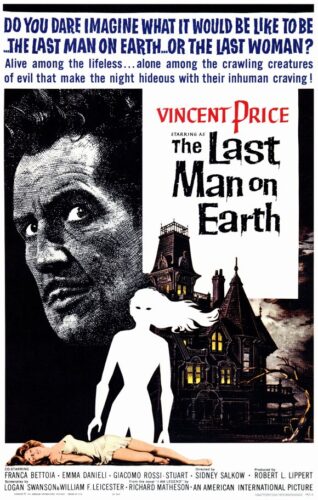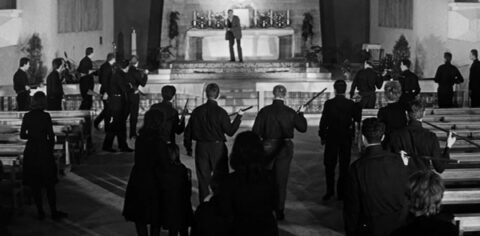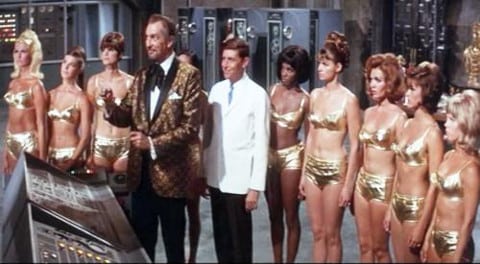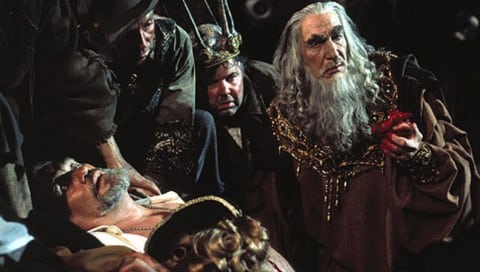The Last Man on Earth (1964)
Directed by: Sidney Salkow
Written by: Furio M. Monetti, Richard Matheson, Ubaldo Ragona, William F. Leicester
Starring: Emma Danieli, Franca Bettoia, Giacomo Rossi Stuart, Vincent Price
ITALY/U.S.
AVAILABLE ON BLU-RAY [Region 1 only], DVD and DIGITAL
RUNNING TIME: 86 mins
REVIEWED BY: Dr Lenera

It’s 1968, and Dr. Robert Morgan lives in a world where everyone else has been infected by a plague that has turned them into undead, vampiric creatures that cannot stand sunlight, fear mirrors, and are repelled by garlic. They would kill Morgan if they could, but are weak and unintelligent. Every day Morgan carries out the same routine: he wakes up, marks another day on the calendar, gathers his weapons, and then goes hunting for vampires, killing as many as he can and then burning the bodies to prevent them from coming back. At night, he locks himself inside his house and uses booze and his records to sooth the sounds of the noises of the undead trying to get in and their taunts. Then one morning he sees a dog, then evidence that there could be other humans nearby….

Richard Matheson’s 1954 novel I Am Legend has been adapted four times. This is understandable, because it’s a terrific novel, though none of the adaptations – this one, 1971’s The Omega Man, 2007’s I Am Legend and I Am Omega [get it?] have been that satisfactory. Okay, I haven’t seen the last of the titles I listed, but it was one of those Asylum direct to video cash-ins on major cinema releases which they’d rush out before the latter came out, so I can’t imagine that it’s much good at all. When Charlton Heston, star of The Omega Man, viewed this first one, he called it “incredibly botched, totally unfrightening, ill-acted, sloppily written and photographed”, which is a bit harsh. His version may have had a larger budget and may actually be the most entertaining of the four, but also isn’t as effective as this one. There is indeed some sloppiness, Chuck not being entirely wrong there, perhaps the most obvious example being that the main house looks rather flimsy with holes showing through the thin boards that ought to easily be penetrated by even these vampires. The decision, brought on because the budget was so very low, to have Rome stand in for San Francisco just doesn’t work at all, the difference being obvious. The vampires are sometimes scary and more often not, while there’s a curious avoidance of onscreen bloodshed. The final act is a bit rushed, even though this is easily the most faithful version to the book. But it has a surprisingly nightmarish feel at times, is also quite emotionally drenching in parts too with the power of the story really coming through, and is excellently lensed by Tonino Delli Colli [Chuck was dead wrong here]. And Vincent Price, while not the obvious choice for his part, does pretty well in an atypical part for him. No camp or glint in the eye here.
The Last Man On Earth was originally intended to be made by Hammer. Producer Anthony Hinds purchased the rights, Matheson wrote a script, and Hammer announced in 1958 that they would make it. However, the BBFC said the script was to horrific to be filmed, so Hinds resold the script to American producer Robert L. Lippert, who’d wanted to make a similar film for a while. He intended to film a novel by George R. Stewart called Earth Abides, but then the release of the similar The World, the Flesh and the Devil killed off plans for that project. Then Lippert’s friend Harry Spalding read Matheson’s novel and suggested Lippert film that book instead. Lippert told Matheson that Fritz Lang would direct the film, and Matheson thought that would be “Wonderful”, though it’s doubtful that Lang was even asked. When the unknown Sidney Salkow was chosen to direct. Matheson said “Well, there’s a bit of a drop.” Matheson wrote another screenplay, which was ‘amended’ by William Leicester, Furio M. Monetti, and Ubaldo Ragona. Differences from the novel included Robert Morgan becoming Robert Neville and his profession being changed from a plant worker to scientist, the vampires no longer being fast and capable of running and climbing, the addition of a blood transfusion, and the ending being extended. Money was saved by shooting on location in Rome and the Esposizione Universale Roma with a predominantly Italian cast and crew. To more accurately show how grueling it was for his character to survive, Price insisted on lifting real people into the back of his car instead of dummies. Matheson felt that the film was “Inept“, so he used a pen name, Logan Swanson, for his screenplay credit. The Last Man On Earth failed at the box office. The Italian version has two dialogue scenes cut from others..
The opening shots of deserted locales and dead bodies are appropriately haunting, though if you look closely later on you may spot some traffic that probably wasn’t meant to be seen. A sign outside a church says THE END HAS COME. The camera tracks in to Morgan through a window, and if you worry that, because his character is alone for much of the time you won’t hear his wonderful voice, don’t – he narrates some passages in the first third. “Another day to live through, better get started” he says wearingly as he gets up out of bed. It’s been three years since he “Inherited the world”, and it soon becomes apparent that the ritual that we see him go through is one he does over and over again. Checking the garlic and mirrors around the house, sharpening stakes on a wood lathe, calling for help on his radio, checking his generator, refurbishing his supply of garlic out of the walk-in freezer of a department store is what it’s all about before staking various vampires throughout the city, returning home and taking a nap before his alarm goes off and he gets up to hear the vampires gathered outside calling “Come out, come out”, which he attempts to drown out by booze and his records. The way he suddenly bursts in on the first vampire victim that we see, a woman who barely has time to notice him, is quite startling, though we wonder how he keeps going with little sleep and little food; he’s says how he’s just not hungry. His back story is introduced by him hearing a young girl’s voice saying “I can’t see”, then visiting a coffin in a church; Price beside a coffin talking to the person inside is the kind of thing that we’re used to seeing Price do, but it somehow hits you in this one. Then, soon after we see Morgan watching home videos, we get a lengthy flashback which might have been better being split up.

So what happened three years before? His friend Ben arrives at a birthday party for Morgan’s daughter bearing an armful of presents, while, against the background of the children’s shouts and laughter, the adults worriedly discuss the appearance of a new virus from Europe that could spread. No, not everyone would want to watch this movie right now, especially with lines like “Is it possible that these germs and virus could be air born” and “I wish somebody would find a vaccine”. Morgan doesn’t believe that things will get bad, but then we cut to some time later when things are bad indeed and Morgan is now one of those working on this vaccine while his wife Virginia and their unnamed daughter are both really ill. The latter crying “Mummy help me” as she turns blind [a symptom] is a very sad moment that certainly hit this critic, and then just after that we see a woman screaming at the people taking her husband’s body away to be burned. The budget wasn’t there to give us a sense of the full scale of the plague accept for the the anonymous, canvas-wrapped corpses being thrown into the 24/7 immolation pit, but we certainly get an emotional sense of it. Morgan tells Virginia not to call a doctor while he’s at work, but she does so anyway while Ben has gone either a bit crazy or a bit vampire-like; it’s hard to tell which. There’s a really good moment of horror when Virginia comes back from the grave [burial is more respectful but there’s of course a risk] with good suspense building, though it then suddenly cuts away so we don’t see what happens after. Then it’s back to the present, but Morgan son has more company in the form of a dog, though the second time they meet it’s clearly infected, leading to more extremely sad moments. Bodies with iron spears sticking in them leads to the appearance of a human woman, Ruth Collins, though she doesn’t like garlic much. In fact she’s part of a group who are infected but are able to keep vampirism at bay with a vaccine.
The last section was fairly short in the book but at least it was still given enough room to play out. Here, it feels like they had to truncate matters in order to keep the running time down, though not having our two leads have a romance was maybe a good idea; the novel’s Morgan may do so but I doubt very much that it’s something that the film’s Morgan would want to do;, he’s become a shadow of a human, and therefore only one step away from the living dead. This is seemingly made clearer by the two scenes missing from export prints which show more of Morgan’s transformation; why oh why, in these days of supposedly definitive editions, are these only in the German Blu-ray release? And we get the bitter irony that Morgan is feared by the half-vampires, is something of a legend himself, which causes the title to make sense. This doesn’t come through in the other versions, though the 2007 film does have an unused ending which would have brought it closer to Matheson’s ideas here. For some reason, some versions of The Last Man On Earth remove shots of a mother and a baby in the final scene which reinforce the sense that this society will expand and maybe even take over the planet. After all, they’re such lethal vampire hunters that they make Morgan’s efforts seem weak by comparison. As for the vampires themselves, it’s easy to forget they’re supposed to be vampires because they behave far more like zombies, and they aren’t generally menacing en masse despite the shots of them outside Morgan’s house having clearly been an influence on Night Of The Living Dead. However, a few little individual moments do come off, despite the makeup being as primitive as can be, and their nighttime taunting of Morgan is rather unsettling. But the film’s squeamishness is rather odd; we see no bites and no stakes go into bodies. In fact there’s practically no blood at all. Of course it’s possible that the writers were thinking of the way the Hammer version was basically nixed by the BBFC and therefore opted to play it safe as a result, but judging by other 1964 horror films they could have got away with a bit more.
Price mostly plays it low key and may not even seem to be trying very hard for some, though I think his approach is right because his character is very cold except in the flashback. He’s a bit old for the role, but projects a vulnerability because he doesn’t look very tough, like someone you’d expect to be the last surviving human. Unfortunately everyone else is dubbed, even though they’re obviously all speaking in English, a non uncommon thing in European films of this time. The occasional bit of lip synching is off too. Sidney Salkow’s direction is mostly workmanlike and often seems to be relying on Colli to make scenes come alive. Colli’s contribution is considerable, with strong use of silhouettes and pools of black. Tight compositions make Morgan’s decently sized house seem quite claustrophobic, and contrast with the wide daytime outdoor shots. Music score composers Bert Shafter and Paul Sawtell provide their usual solid if unremarkable effort, underlying the story’s moods fairly well. The track that accompanies the vampires trying to get into the house is almost identical to the one that accompanies the giant Cormoran in the same composer’s Jack The Giant Killer. The Last Man On Earth is indeed seriously flawed, but it still has some power and, more than in any other version, you can see the movie that Matheson’s tale has the potential to be as a motion picture. The elements are all there, but a combination of iffy decisions and too low a budget can’t quite make them cohere and work as well as they should. It feels like an early version of a classic that doesn’t exist – so far. Come on, somebody. Make it.







Be the first to comment